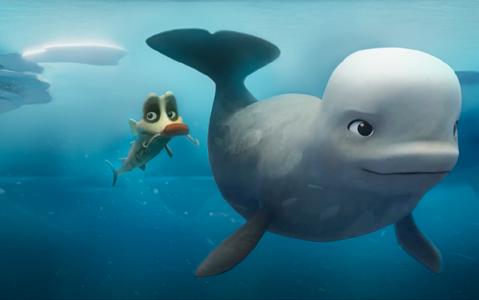
2 minute read
ODDlAnD
from ECFA Journal September 2022
by ECFA
Bert Lesaffer & Astrid Yskout about ODDLAND
Advertisement
A bunch of bizarre animals are playing on the savanna. They look like giraffes, without a neck. When Gerda suddenly feels her neck grow, playing hide-and-seek becomes even more difficult.
Screenwriter Bert Lesaffer: ODDLAND tells about an animal species with a characteristic that we consider normal, but which is actually completely bizarre. A giraffe’s neck is visually very striking and makes you question what is ‘normal’ and what is ‘different’. What happens when someone deviates from the group norm? Actually, what we depict is a hyper-condensed version of the theory of evolution.
With those long legs and necks, giraffes might seem hard to animate. Don’t you regret not having simply chosen dogs or fishes?
Graphic designer Astrid Yskout: My graphic style is not completely realistic; no biological correctness was required in the body movements. And I’m not fond of bright colours; my style is more dampened, inspired by the Eastern European tradition from the 1970s, like The Little Mole.
How many hours did you camp in front of the giraffe enclosure in the zoo?
Yskout: We did watch YouTube videos, but then ignored most of that research. The hardest thing to animate was actually not the legs, but the spots. The pattern shouldn’t be too complicated. That is why our giraffes initially mainly have short stripes on their fur.
On closer inspection, giraffes look like a totally whacked species…
Lesaffer: How do you recognise a giraffe? By its long neck! If that is not there, is it still a giraffe you’re looking at? And will children recognise it as such? We made those little calves look extra clumsy, as they have no neck; their heads are immediately fixed to their bodies. They can’t even look upwards.
Being different also has its advantages.
Lesaffer: This story refers to how I felt as a child and how I look back on the fear of being excluded from the group for ‘being different’. Even as an adult the urge is still there: everyone wants to belong to a group, but also claims to have something unique and special. On the other hand, ‘being different’ can help open a gate to a new world, which is exactly what happens to Gerda.
You could make similar films about so many different animal species…
Lesaffer: Why not? What about a hedgehog without spikes? There is so much more to tell about group dynamics and who knows… maybe we will…
What about the sound? You don’t use those classic kids voices.
Lesaffer: It was certain from the beginning that we would not have dialogues but communicate through sounds and body language. Giraffes don’t make a sound. Well, they do, but we don’t hear it. They buzz at a frequency that the human ear cannot pick up. So we started from a sheepish bleat, that goes from high to low – which seems inevitable with giraffes! That contrast between high/low is interwoven throughout the film, for instance with a stone rolling down the hill. Yskout: That stone is gender fluid, by the way. With open eyes she looks neutral, but when the stone closes her eyes you see her curly lashes, which adds something girly to the character. Those are the kind of details that I adore!
–
Gert Hermans










